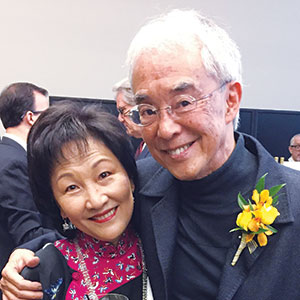

An official Dr. Jerry Hiura table should be established at Kubota Restaurant in Japantown. In fact, there should also be an official Dr. Jerry walking tour of J-town, beginning at 90 E. Taylor and concluding at Kubota.
Hiura, who passed away on Dec. 26 at age 72, was one of the all-time legends of J-town. A dentist by trade, Dr. Jerry operated from his celebrated Taylor Street office, yet was always willing to inspect someone’s teeth, even in his own driveway.
Many also knew Dr. Jerry as a relentless supporter of the arts. Not only did he help launch Contemporary Asian Theater Scene (CATS), he also at various times over the decades served as vice chair of the California State Arts Council, chair of the San Jose Arts Commission and president of Arts Council Silicon Valleyall of which led him to forever champion the plights of various cultures and diasporas in the arts, helping everyone while expecting absolutely nothing in return.
Several people in the arts community went to Dr. Jerry to get their dental work done. Always a mega-modest beacon of light and laughter, Dr. Jerry would talk to patients about art spaces, theater jobs, Asian-American struggles or issues concerning non-profit statusall while he worked on their teeth. He brought a smile to everyone’s face.
“He was my dentist for years,” said Tamara Alvarado, who ran MACLA from 2003 to 2008. “I loved coming in and laughing because he would ask me questions the entire time with torture instruments in my mouth. He knew I could only nod or gesture dramatically, and he laughed and I laughed.”
A perfect example of the role Dr. Jerry played as a humble yet powerful networking machine emerged when he helped integrate Chopsticks Alley Art, a Vietnamese-centric arts operation, into the fabric of Japantown so that a landmark exhibit, Salt Stained, could take place at Ken Matsumoto’s Art Object Gallery in 2018. After 40 years of the Vietnamese diaspora enduring in San Jose, it had never once collaborated with the Japanese American community.
Trami Nguyen Cron, founder and executive artistic director of Chopsticks Alley Art, says she was previously unfamiliar with the arts community and social structure of Japantown, yet Dr. Jerry, who also became her dentist and one of her board members, functioned as a conduit to help the organization find its way. Many meetings unfolded at Kubota, where Dr. Jerry held court and even had his own tab and his own table, it seemed. Cron would sneak over and try to pay, but the staff wouldn’t take her money. Jerry always covered it.
“He was very humble,” Cron said. “What I liked about him … I regret not knowing so much. Not because of lack of trying, but because he was so about other people. You go to him and it’s all about you, not him. You’d try to turn it, and ask about him, his family, his life, but in his way, he’d somehow brush it off and talk about you. He was always about other people, not about himself.”
Kathy Sakamoto, president of San Jose Okayama Sister Cities, agreed, adding that Dr. Jerry always responded to phone calls, whether he was in San Jose, Morocco or London. He was always trying to make light of difficult situations while working on solutions at the same time.
“He sprinkled words and checks around like fairy dust, enabling care for the arts community, the Asian Pacific and Islander community, civil rights and more,” Sakamoto said. “He sincerely loved his community of family, friends and patients.”
Later this summer, art shows and other events will celebrate Dr. Jerry’s life and creativity, since he also wrote poetry, made jewelry and painted. Until then, though, his humble presence will be felt all over Japantown.



